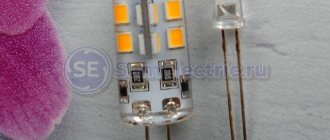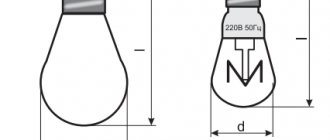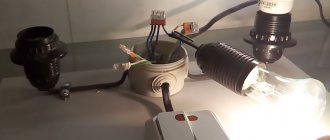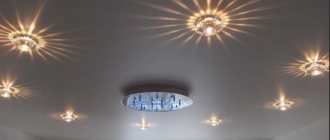Almost everyone today is familiar with Ilyich's light bulbs, which over the past decades of widespread use of electricity for lighting have been in every apartment and room. Despite the increasing pace of transition to the era of energy-saving technologies, many continue to use lamps with this technology. During operation, quite often a situation occurs when an incandescent lamp burns out. This type of lighting equipment is already characterized by a low operating time, therefore, when the service life is reduced by half or three times, a completely rational question arises about the reason for what happened.
Main causes of burnout
The reasons can be different - from power surges, poor-quality contacts in the electrical circuit to frequent switching on/off of devices, high temperatures, and vibrations.
Power surges
The industrial voltage is 220 V. If the actual value exceeds the required value, the tungsten filament overheats significantly, which shortens its service life.
A multimeter is used to check the voltage. Measure the value two to three times a day, since jumps are possible during a certain period. For example, this happens in the evenings, when people return from work or businesses connect to the electrical network at home. Another sign of high voltage is that parallel to the burnout of the light bulbs, the plugs and circuit breakers are knocked out.
If you detect power surges in the network, proceed as follows:
- buy lamps designed for higher voltage - for 230 - 240 V (look for the value on the packaging or on the base of the product);
- additionally install protective blocks for incandescent lamps on each switch (protect against overvoltage, ensure smooth switching);
- use a stabilizer installed in the first distribution box of the apartment (protects electrical appliances in the house);
- buy fluorescent lamps that are not affected by power surges;
- use LED products.
Important! Knocking out traffic jams and machines is not always associated with increased voltage. This also happens in cases where the total power of electrical appliances connected to the network exceeds the permissible limit. Don't forget to short circuit the electrical wiring.
Poor quality contacts in the socket
Old domestic lamps used plastic sockets, and the cheaper the product, the lower the quality of the material itself. Ceramic cartridges are better, but are used less often. These lamps are designed for light bulbs up to 40 W. If you take a 60 W lamp, over time the socket will begin to crack. This will lead to oxidation and burning of the contacts. Poor contacts are another reason for the lamp to overheat and burn out.
If the light bulbs constantly burn out in one lighting fixture, and when the light is on, you hear extraneous sounds with a change in brightness, look for the cause in poor-quality contacts on the sockets. Clean them, replace burnt cartridges or the entire lamp. Avoid using devices with lamps of higher power than indicated in the lamp data sheet.
If the conditions are met, there is not enough light, switch to using luminescent products. Most modern lighting devices set an important requirement on the sockets - the power of the lamps used is not higher than 40 V. There is no need to limit the luminous flux and illumination of the room - it is possible to use fluorescent lamps.
Correct wire connection
The next reason is a wiring fault. Check the connections inside the electrical panel and tighten the screws that are responsible for securely fastening the cables.
If plugs and circuit breakers are knocked out when a light bulb burns out, be sure to check the compliance of the power of electrical appliances in the house with the electricity consumed. If a malfunction or insufficient power parameters are detected, the identified products must be replaced.
Examine the connections in each junction box of the apartment (private house). Pay attention to blackened wires and melted areas. Clean such contacts and tighten loose connections. Be sure to replace twisted wires with high-quality connectors.
Avoid galvanic pairs, when two or more cables of different metals are connected by twisting. In such areas, severe overheating occurs. If such cases cannot be avoided, use pads.
Problem switch
The next step is to check the switches. If such an element does not work correctly, incandescent lamps may also burn out. Disassemble and inspect the condition of the contact elements. If you notice sparks, carbon deposits on the contacts, or traces of blackness on the wires clamped with screws, get rid of the switch and install a new one.
If light bulbs turned on by one button burn out, do not disassemble the switch. Replace with a new one, additionally install a dimmer that provides smooth switching and the ability to change brightness.
Switches vary in terms of service life - replace the electrical product in a timely manner.
Poor quality lamp
Incandescent lamps from domestic manufacturers are significantly inferior in quality to their foreign counterparts. Lamps with a power of up to 60 W, most often used in everyday life, burn out. If previously domestic products were better in price, now their cost is comparable to devices from Osram and Philips factories. In this case, give preference to the latter group.
There are various recommendations for choosing lamps, but before you run to the store for foreign analogues, make sure that they are the problem.
Frequent activation
When turned off, the tungsten filament is cold, which is why its resistance is lower than that of the lamp when it is on (with a heated filament). When switched on, the current flowing through the electrical product is significantly higher. If frequent switching on/off occurs, the starting current will lead to rapid evaporation and breaking of the filament.
Vibration and mechanical stress
Constant vibrations, shocks and other mechanical impacts lead to rapid burnout of incandescent lamps. The way out of the situation is to replace conventional products with LED or compact fluorescent ones.
What to do if light bulbs burn out quickly
In most cases, lamps burn out due to users violating the rules for operating networks. Also, any mechanical stress reduces the service life of the lighting source.
The best solution would be to replace conventional sources with modern LED lamps that have increased resistance to voltage surges, vibrations, and operating temperature conditions.
It is better to replace it with LED lighting.
If there is high humidity or a specific temperature in the room with the lamp, then it is necessary to select a device with an appropriate level of protection from such influences. Usually this information is indicated by the manufacturer on the packaging.
Why do halogen lamps burn out?
Halogen lamps are rarely used in household appliances. These are mainly spotlights, less often chandeliers. One of the main reasons for failure is contact with bare hands, which leads to grease stains on the surface. The products overheat significantly, which causes the flask to collapse.
Use clean gloves during installation. If dirt is found, remove it with an alcohol-soaked cloth. Halogen lamps can burn out due to technically incorrect installation of electrical wiring going to the place where the spotlight is used.
Solution
The problem of premature lamp failure can be solved by adding a protective unit to the lighting circuit. Such a circuit can equalize small voltage drops. Only it is applicable only to incandescent or halogen lamps. This unit does not work with fluorescent and energy-saving lamps.
According to the standards of GOST 13109-97 “On voltage”, for single-phase networks of 220 volts the maximum permissible interval is 198-242 V. Taking into account the norm, the manufacturer is obliged to produce electric lamps designed for the maximum limit.
However, in reality everything is different: without violating the standard, lamps are manufactured for a nominal voltage of 230 volts. Each incandescent lamp manufacturer sets the nominal voltage for each lamp model differently. Thus, it turns out that one type of “premium class” product with an appropriate design, the other is “economy”.
There is only one way out for the population - to use products from world brands that care about their reputation in the market. This is how a light bulb business turns out.
The manufacturer produces a cheap, short-lived product, hoping that the consumer will buy it again and again. Or a well-known company produces high-quality, durable and more expensive products. What to choose is up to everyone to decide for themselves, based on their beliefs and preferences.
Recommendations for extending the life of incandescent lamps
The service life of light bulbs depends on the correct construction of the electrical wiring, the device used, power surges, mechanical shocks, temperature and the switch.
Prolonged operation of the product leads to overheating of the tungsten filament and its gradual evaporation. Because of this, the diameter decreases and the thread sooner or later burns out (breaks). The higher the heating temperature of the tungsten filament, the brighter the glow will be, characterized by a faster evaporation process and a shorter service life.
On average, the lamp is designed to operate for 1000 hours. After approximately 750 hours, the luminous flux decreases by 15%.
A slight increase in network voltage (about 5%) reduces the service life by half. This can be verified by observing lighting products installed on staircase landings, which constantly operate at night, when there is minimal load on the electrical network, which leads to an increase in voltage.
Since the tungsten filament is very cool when turned off, it is advisable to warm it up with a lower current before turning on the incandescent lamp at full power. To do this, install dimmers.
Rated voltage
Modern products do not indicate a specific voltage, but a certain range - from 215 to 225, 230 to 240 V. If the lamp is operated within this range, good luminous flux and durability are ensured.
This approach of manufacturers is associated with the difference in operating voltage of the network in its different sections. Near the source (substation) it will be higher than far from it. For this reason, you need to select light bulbs in accordance with the apartment’s network voltage. Measure it with a multimeter and if it turns out that the parameter is 230 V, buy incandescent lamps with a range from 30 to 240 V.
Checking the cartridge
If lamps in the same socket burn out frequently, check its operating temperature. If it is hot, disassemble the product, clean and bend the central and side contacts, and then tighten the wires going to the cartridge. If light bulbs in a chandelier often burn out, try using products of the same power.
Application of a protective diode
Recently, electricians have been using diodes installed in front of incandescent lamps on staircase landings. The quality of the voltage does not decrease, and the service life increases. If you connect a resistor in series with the diode, the light bulb will last for many years.
Preventive actions
To avoid premature failure of the lamp, it is necessary to connect the device in accordance with all the rules, equip the network with stabilizers, and also follow the operating recommendations. Methods for extending the life of light bulbs deserve special consideration.
Extending light bulb life
If the cause of the burnout is an excess of the supply voltage, it is necessary to measure the corresponding indicators in the network. It is advisable to carry out diagnostics three times a day, identifying the highest value. It is he who needs to be hired as a worker for a specific apartment. The lamp rating indicated on the bulb must correspond to this voltage. On sale you can find elements with ranges of 215-235 V, 220-230 V and 230-240 V.
Minimizing vibrations and shock impacts will help increase the service life of the product. If you still have to frequently move the lamp from one place to another, it is better to choose a low-voltage light bulb with a short incandescent spiral.
Low voltage incandescent lamp.
The presence of one constantly burning source in a chandelier with several bulbs indicates a malfunction in the socket. You need to carefully check the device for outgoing contacts. They need to be cleaned of carbon deposits and tightened.
Increasingly, electricians are installing special diodes in the circuit in front of the lamp, which increase the life of the system without reducing the quality of lighting. If you also connect a resistor in series with the diode, the light source will work for many years.
How to prevent light bulbs from burning out frequently
Protection unit for halogen and incandescent lamps
There are several preventive measures that will extend the service life of lamps at home.
- Use diodes to protect lamps. As practice shows, diodes have virtually no effect on the quality of lighting, and their service life is significantly extended.
- Regular maintenance of the cartridge. It is recommended to periodically inspect and protect the contacts and, if necessary, tighten the connections.
- If possible, reduce the influence of vibration and shock, especially when it comes to incandescent lamps.
Electricians with many years of experience recommend installing light bulbs of the same power in chandeliers, this ensures even distribution of the load.











